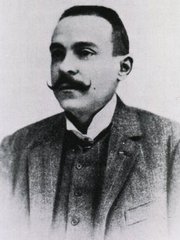This article is part of the series "A Moment in History" where we honor those who have contributed to the growth of medical knowledge in the areas of anatomy, medicine, surgery, and medical research.

Ruggero Oddi
Ruggero Oddi (1864-1913). Anatomist and physician, his complete name was Ruggero Ferdinando Antonio Giuseppe Vincenzo Oddi Pampaglini, born on July 20, 1814 in the city of Perugia, Italy. He studied medicine in the University of Perugia, where he had a keen interest in anatomy and physiology, graduation with a medical degree in 1889. In 1887, as a fourth year medical student Oddi published a paper that would make his name eponymically tied to the sphincter found around the hepatopancreatic ampulla; what today is known as the "sphincter of Oddi". His paper was entitled "Di una Speciale Disposizione a Sfintere allo Sbocco del Coledoco" (On a Special Sphincteric Arrangement at the Outlet of the Common Bile Duct).
Although the circular muscle of the sphincter of Oddi had already been described by Glisson in 1681, Oddi was the one who did a complete anatomical and physiological study of this structure uncovering the fact that it was indeed a sphincter. He continued his studies on the hepatobiliary sphincter until 1894, when he moved to Congo and later back to Belgium.
Because of his inclination towards metaphysical studies, Oddi started experimenting with drugs on himself and became addicted.
His later life was surrounded by scandal and controversy, because of drug abuse and fiscal mismanagement of University funds. Oddi died in poverty in 1913 and his site of burial is unknown.
Sources:
1. "Ruggero Ferdinando Antonio Guiseppe Vincenzo Oddi" Lukas, M, et al. World J Surg (2007) 31:2260–2265
2. "Ruggero Oddi; To commemorate the centennial of his original article--"Di unaspeciale disposizione a sfintere allo sbocco del coledoco" Ono, K; Hada, R. Jap J Surg, VOL. 18, No. 4 pp. 373-375, 1988
3. "Ruggero Oddi: 120 years after the description of the eponymous sphincter: A story to be remembered" Capodicasa, E. J Gastroent Hepat 23 (2008) 1200–1203
4. "Oddi: The Paradox of the Man and the Sphincter" Modlin, IM; Ahlman, H. Arch Surg 129 (1994) May 550-557
Original image in the public domain, courtesy of the National Library of Medicine.



